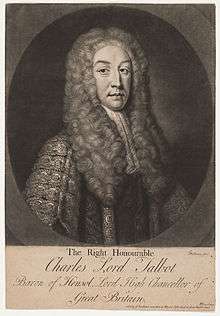Charles Talbot, 1st Baron Talbot
| The Right Honourable The Lord Talbot PC | |
|---|---|
 Lord Talbot, by John Vanderbank | |
| Lord Chancellor | |
|
In office 1733–1737 | |
| Preceded by | The Lord King |
| Succeeded by | The Lord Hardwicke |
| Personal details | |
| Born | 1685 |
| Died |
14 February 1737 Lincoln's Inn Fields |
| Alma mater | Oriel College, Oxford |

Charles Talbot, 1st Baron Talbot PC (1685 – 14 February 1737) was a British lawyer and politician. He was Lord Chancellor of Great Britain from 1733 to 1737.
Life
Talbot was the eldest son of William Talbot, Bishop of Durham, a descendant of the 1st Earl of Shrewsbury. He was educated at Eton and Oriel College, Oxford, and became a fellow of All Souls College in 1704. He was called to the bar in 1711, and in 1717 was appointed solicitor general to the prince of Wales. Having been elected a member of the House of Commons in 1720, he became Solicitor General in 1726, and in 1733 he was made lord chancellor and raised to the peerage with the title of Lord Talbot, Baron of Hensol, in the County of Glamorgan.[1]
Talbot proved himself a capable equity judge during the three years of his occupancy of the Woolsack. Among his contemporaries he enjoyed the reputation of a wit; he was a patron of the poet James Thomson, who in The Seasons commemorated a son of his to whom he acted as tutor; and Joseph Butler dedicated his famous Analogy to Talbot. The title he assumed derived from the Hensol estate in Pendoylan, Glamorgan, which came to him through his wife.[1]
After an illness during which the King and Queen enquired after his health every day, Talbot died on 14 February 1737 at his home in Lincoln's Inn Fields.[2]
Talbot is remembered as one of the authors of the Yorke–Talbot slavery opinion, as a crown law officer in 1729. The opinion was sought to determinate the legality of slavery: Talbot and Philip Yorke opined that it was legal. The opinion was relied upon widely before the decision of Lord Mansfield in Somersett's Case.
Family
Talbot married, in the summer of 1708, Cecil Mathew (died 1720), daughter of Charles Mathew of Castell y Mynach, Glamorganshire, and granddaughter and heiress of David Jenkins of Hensol. There he built a mansion in the Tudor style, known as the Castle. They had five sons, of whom three survived him. He was succeeded in the title by his second son, William (1710–1782).[3]
References
- Lord Campbell, Lives of the Lord Chancellors and Keepers of the Great Seal (8 vols. London, 1845–69)
- Edward Foss, The Judges of England (9 vols. London, 1848–64)
- Lord Hervey, Memoirs of the Reign of George II ( 2 vols. London. 1848)
- G. E. Cokayne, Complete Peerage, vol. vii. (London, 1896)
Notes
- 1 2 Chisholm 1911.
- ↑ "From Wye's Letter and the London Prints, Feb 15". Newcastle Courant. 19 February 1737. Retrieved 26 January 2016 – via British Newspaper Archive. (subscription required (help)).
- ↑
 Lee, Sidney, ed. (1898). "Talbot, Charles (1685-1737)". Dictionary of National Biography. 55. London: Smith, Elder & Co.
Lee, Sidney, ed. (1898). "Talbot, Charles (1685-1737)". Dictionary of National Biography. 55. London: Smith, Elder & Co.
References
 This article incorporates text from a publication now in the public domain: Chisholm, Hugh, ed. (1911). "Talbot of Hensol, Charles Talbot, 1st Baron". Encyclopædia Britannica. 26 (11th ed.). Cambridge University Press.
This article incorporates text from a publication now in the public domain: Chisholm, Hugh, ed. (1911). "Talbot of Hensol, Charles Talbot, 1st Baron". Encyclopædia Britannica. 26 (11th ed.). Cambridge University Press. Lee, Sidney, ed. (1898). "Talbot, Charles (1685-1737)". Dictionary of National Biography. 55. London: Smith, Elder & Co.
Lee, Sidney, ed. (1898). "Talbot, Charles (1685-1737)". Dictionary of National Biography. 55. London: Smith, Elder & Co. - Macnair, M. "Talbot, Charles, first Baron Talbot of Hensol (bap. 1685, d. 1737)". Oxford Dictionary of National Biography (online ed.). Oxford University Press. doi:10.1093/ref:odnb/26923. (Subscription or UK public library membership required.)
| Parliament of Great Britain | ||
|---|---|---|
| Preceded by Sir Edmund Prideaux James Craggs |
Member of Parliament for Tregony 1720–1722 With: James Craggs to 1720 Daniel Pulteney 1720 – March 1721 John Merrill from March 1721 |
Succeeded by James Cooke John Merrill |
| Preceded by George Baker Thomas Conyers |
Member of Parliament for City of Durham 1722–1734 With: Thomas Conyers to 1727 Robert Shafto 1727–1730 John Shafto from 1730 |
Succeeded by Henry Lambton John Shafto |
| Legal offices | ||
| Preceded by Clement Wearg |
Solicitor General for England and Wales 1726–1733 |
Succeeded by Dudley Ryder |
| Political offices | ||
| Preceded by The Lord King |
Lord Chancellor 1733–1737 |
Succeeded by The Lord Hardwicke |
| Peerage of Great Britain | ||
| New constituency | Baron Talbot 1733–1737 |
Succeeded by William Talbot |
.svg.png)
